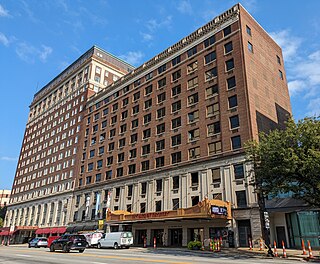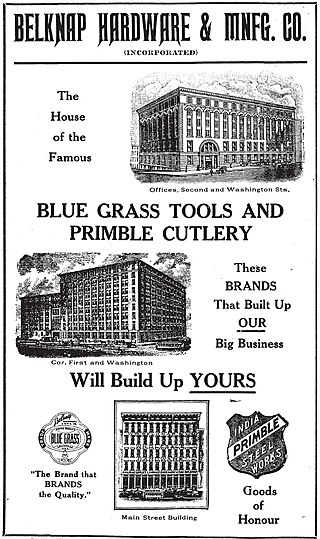
Greensboro is a borough in Greene County, Pennsylvania, United States. The population was 267 at the 2020 census, up from 260 at the 2010 census.

Riedel Crystal is a glassware manufacturer based in Kufstein, Austria, best known for its glassware designed to enhance different types of wines. According to Petr Novy, Chief curator Museum of Glass and Jewellery in Jablonec nad Nisou, Czech Republic, Riedel is the oldest family owned and operated global crystal glass brand worldwide. Established in Bohemia in 1756, the company is managed by Georg Riedel and Maximilian Riedel. Later, it was re-established by Claus J. Riedel in 1956, with the support of the Swarovski family.

400 West Market is a skyscraper in Downtown Louisville, Kentucky. The 35-story, 549-foot (167 m) high structure was designed by architect John Burgee with Philip Johnson. It was Kentucky's tallest building when built for $100 million in 1991. Its groundbreaking ceremony occurred in July 1991 with initial occupancy in October 1992 and final occupancy in April 1993. Originally called Capital Holding Building and later, Capital Holding Center, the structure was later renamed Providian Center then Aegon Center as the business was renamed and sold. Aegon left the building in 2010, and the building was renamed 400 West Market in 2014.

The 800 Tower, formerly The 800 Apartments, is a 29-story residential skyscraper in Louisville, Kentucky, located in the city's SoBro neighborhood, nestled between Old Louisville and downtown. At the time construction was complete in 1963, The 800 was the tallest building in Louisville, a record it maintained for nearly a decade.

The Whitall Tatum Company or Whitall Tatum (1806–1938) was one of the first glass factories in the United States.

Louisville City Hall is a registered historic building in Louisville, Kentucky, placed on the National Register of Historic Places in 1976. Completed in 1873 to house the Louisville city government, the structure is located at 601 West Jefferson Street in what became Downtown Louisville, the center of the city's civic district.

Canberra Glassworks is an Australian gallery in Canberra and glass art studio open to the general public to view the glass artists working. Opened in May 2007 by Jon Stanhope, it is the largest dedicated glass studio facility in Australia.
Ravenhead Glass was a glassworks near Ravenhead Colliery, Lancashire, North West England. It was founded in 1850 by Frances Dixon and John Merson after a move from their earlier (1842) factory at Thatto Heath near St Helens. In 1852, this factory was sold to the Pilkington Brothers and Frances Dixon then acquired a 13-acre (53,000 m2) site at Ravenhead, building a new gas-powered glassworks.

The W. L. Lyons Brown Theatre, originally called the Brown Theatre, is a restored theatre dating back to 1925 that seats approximately 1,400 patrons in Louisville, Kentucky. It is ones of three venues owned by Kentucky Performing Arts.

Congregation Adath Israel Brith Sholom is a Reform Jewish congregation and synagogue located at 5101 US Hwy 42, in Louisville, Kentucky, in the United States.
Grönvik glasbruk or simply Grönvik was a glassworks in the present-day Grönvik village in Korsholm, Western Finland. It was founded by merchant Johan Grönberg and existed from 1812 to 1907. Several glass manufactures were produced at Grönvik. At first bottles and drinking-glass were made here, but beginning in the 1890s solely window glass. Also pharmaceutical glass was manufactured. The glassworks produced as the first factory in Finland pressed glass, which came about from the 1840s. The domestic market for glass was during the time of the glassworks smallish and glassblowing products were exported to e.g. Lübeck, Saint Petersburg, Stockholm and Denmark, as well as to other parts of Europe. Grönvik was able to successfully assert its position, despite the competition from other glassworks in Finland. Eventually, it became the most distinguished in the country. The glassworks also become the largest in the Nordic countries.
The Albany Glassworks Site is an archeological site in Guilderland, Albany County, New York. Approximately 2 acres (0.81 ha) in size, it was listed on the National Register of Historic Places in 1980.
Luckett & Farley is an architecture, engineering, and interior design firm based in Louisville, Kentucky. It was founded in 1853, making it the oldest continually operating architecture firm in the United States that is not a wholly owned subsidiary. The firm began under the name Rogers, Whitestone & Co., Architects, changing its name to Henry Whitestone in 1857, to D.X. Murphy & Brother in 1890, and to Luckett & Farley in 1962. The company is 100% employee-owned as of January 1, 2012 and concentrates on automotive, industrial, federal government, higher education, health and wellness, and corporate/commercial markets. There are more LEED professionals at Luckett & Farley than any other company in Kentucky with 50, as of December 2012.
J. H. Hobbs, Brockunier and Company was one of the largest and best-known manufacturers of glass in the United States during the 19th century. Its products were distributed worldwide. The company is responsible for one of the greatest innovations in American glassmaking—an improved formula for lime glass that enabled American glass manufacturers to produce high-quality glass at a lower cost. The firm also developed talented glassmakers that started glass factories in Ohio and Indiana.

The Belknap Hardware and Manufacturing Company, also known as the Belknap Hardware Company or simply Belknap Hardware, was at one time a leading American manufacturer of hardware goods and a major wholesale competitor of retail sales companies Sears, Roebuck, and Company and Montgomery Ward. Located in Louisville, Kentucky, Belknap excelled both in catalog sales and widespread distribution of its own name-brand manufactured products.

Nailsea Glassworks was a glass manufacturing factory in Nailsea in the English county of Somerset. The remaining structures have been designated as a scheduled monument.

John Andrewartha was an English architect and civil engineer.

RONA a.s. is a Slovak drinking glass manufacturer, established in Lednické Rovne, Slovakia, in 1892. The name RONA comes from the former naming of the village ‘‘Lednicz Rone’’. The company manufactures unleaded drinking glasses, known as crystal glass. 96% of production is exported and is available in more than 80 countries worldwide. The yearly production of the company exceeds 60 million pieces (2016). Product segments include households, the gastronomy business, aerospace, and ship catering.













